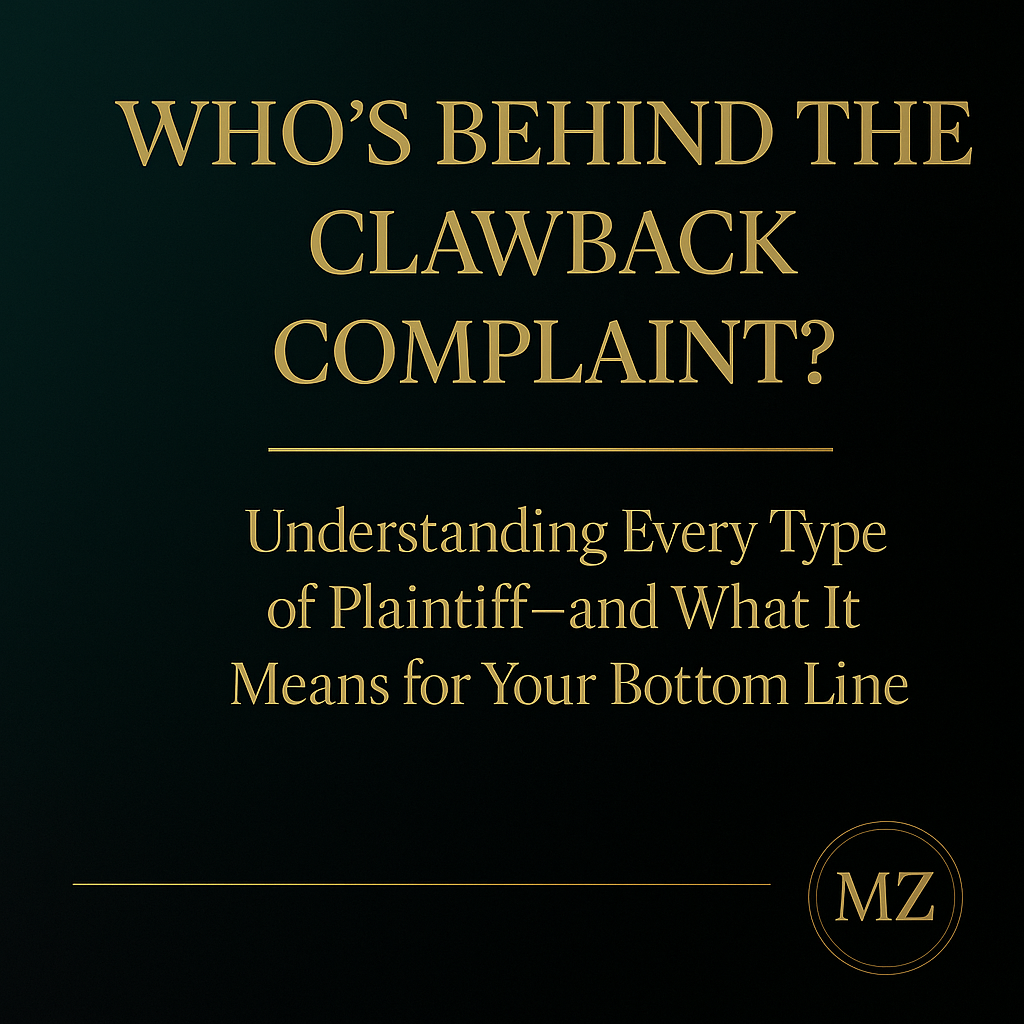When the Complaint Hits the Docket
Executives rarely learn they’ve been sued through formal service. More often, a bankruptcy attorney or industry contact sends an alert:
“You’ve been named in an adversary proceeding. A summons was issued—your response deadline is already running.”
That thirty-day period begins the moment the summons is issued by the court, not when the company receives the paperwork. By the time the complaint circulates internally, several days may already have passed.
At that point, speed and clarity matter. The first question isn’t “How do we respond?”—it’s “Who filed this, and what does that mean for us?”
Why the Plaintiff’s Identity Changes Everything
Every avoidance complaint originates from someone tasked with recovering money for the bankruptcy estate.
That fiduciary’s title—Trustee, Liquidating Agent, Debtor-in-Possession, Committee, or Litigation Trust—reveals everything about their motives, leverage, and likelihood of early resolution.
Recognizing who’s behind the complaint from the start allows executives to respond strategically and align defense spending with likely ROI.
1. Debtor-in-Possession (DIP)
Who they are:
Existing management operating the business during Chapter 11 while acting as fiduciary for creditors.
Motivation:
Preserve operations, credibility, and liquidity.
What to expect:
Initially pragmatic and reputation-conscious. Once financing or plan approval is secured, remaining claims may transfer to a post-confirmation trust that takes a harder line.
Financial impact:
Engaging early—before assignment—can lead to steep settlement discounts and preserve commercial relationships.
2. Chapter 11 Trustee
Who they are:
An independent fiduciary appointed by the court to replace management for cause or conflict.
Motivation:
Demonstrate diligence and re-establish confidence in estate oversight.
What to expect:
Formal pleadings, structured discovery, and slower settlement approvals due to court supervision.
Financial impact:
Higher procedural friction, but early factual analysis (ordinary-course or new-value evidence) can unlock resolution before litigation costs escalate.
3. Liquidating Trustee, Plan Administrator, or Liquidating Agent
Who they are:
A fiduciary appointed under a confirmed Chapter 11 plan to wind down remaining assets—essentially a private trustee.
(Example: Sharon Stolte, Liquidating Agent in the Continental American Corporation case.)
Motivation:
Maximize recoveries efficiently, often under a performance-based fee structure.
What to expect:
Large-scale litigation portfolios managed for speed. They’re typically receptive to data-driven settlements that save legal fees.
Financial impact:
Strong documentation and proactive outreach can reduce exposure by 70–90 percent before discovery even begins.
4. Chapter 7 Trustee
Who they are:
A panel trustee appointed by the U.S. Trustee to liquidate the estate (for instance, Roger Schlossberg in Prosperity Partners Inc.).
Motivation:
Convert all estate assets—including lawsuits—into cash.
What to expect:
Procedural precision and broad discovery. Settlements often take longer due to required court approvals.
Financial impact:
Overall recoveries may be lower, but missing early deadlines (measured from the summons issuance date) can result in defaults or sanctions.
5. Creditors’ Committee
Who they are:
An official committee representing unsecured creditors, sometimes granted standing to file avoidance actions if the debtor declines.
Motivation:
Protect collective recoveries while maintaining neutrality and credibility.
What to expect:
Well-documented litigation, but negotiation-friendly once business justifications are clear.
Financial impact:
Moderate exposure; committees often prefer negotiated resolutions that reduce administrative expense.
6. Litigation Trust or Recovery Trust
Who they are:
A post-confirmation entity managed by turnaround professionals or former CROs—created solely to pursue lawsuits (e.g., the iCap Trust).
Motivation:
Monetize litigation recoveries; litigation is their business model.
What to expect:
Rapid filing cadence and tight discovery schedules, but pragmatic settlements once recovery benchmarks are met.
Financial impact:
Presenting clear data early can drive deep discounts; ignoring deadlines invites quick, decisive judgments.
Putting It All Together: One Complaint, Six Realities
Imagine your company supplied critical components to a national distributor that later filed for bankruptcy. Months later, your general counsel forwards a message: “We’ve been named in a clawback complaint. The summons was issued last week.”
Now, everything depends on who’s suing you.
- If it’s a Debtor-in-Possession: Expect an opportunity for dialogue. Their goal is optics and reorganization, not public disputes.
- If it’s a Chapter 11 Trustee: Prepare for formal discovery but know that detailed payment data can still drive a negotiated reduction.
- If it’s a Liquidating Trustee or Plan Administrator: They want efficient recoveries. A prompt, well-supported response can resolve the matter quickly and favorably.
- If it’s a Chapter 7 Trustee: Anticipate thorough process and slower timelines. Early participation helps shape settlement on reasonable terms.
- If it’s a Creditors’ Committee: Collaboration and credibility matter. A transparent defense file accelerates compromise.
- If it’s a Litigation Trust: This is a numbers game. The sooner you engage, the stronger your leverage before they meet recovery quotas.
The facts of your case don’t change—but the plaintiff’s identity determines the tone, pace, and cost of resolution.
At-a-Glance Comparison
Plaintiff Type | Appointed By | Motivation | Settlement Flexibility | Typical ROI for Defendants |
Debtor-in-Possession | Existing management / court | Reorganize and preserve relationships | High | Moderate |
Chapter 11 Trustee | Bankruptcy court | Restore confidence | Low–Moderate | Variable |
Liquidating Trustee / Plan Admin | Confirmed plan | Recover efficiently | High | High (fast settlements) |
Chapter 7 Trustee | U.S. Trustee | Complete liquidation | Low | Moderate |
Creditors Committee | Court order | Represent unsecured creditors | Moderate | Moderate |
Litigation Trust | Plan of reorganization | Monetize litigation portfolio | High | High (structured deals) |
How Executives Should Respond
- Confirm the summons issuance date.
The thirty-day window under Rule 7012 begins there—not at receipt. - Identify the plaintiff’s title.
The caption tells you the litigation’s economic model. - Request a concise case summary from counsel.
Determine whether this is a plan-related, trust-based, or converted case. - Act early.
Each day lost narrows your settlement leverage and raises defense costs.
The Executive Takeaway
Once a complaint is filed, the clock is already ticking. The faster your team identifies who is behind the lawsuit, the sooner you can manage exposure and protect the company’s capital.
At The Law Office of Magdalena Zalewski PLLC, we analyze fiduciary behavior and litigation posture from the moment a complaint appears on the docket - often before formal service occurs. That insight allows our clients to resolve complex preference and fraudulent-transfer actions efficiently and with measurable ROI.
If you’ve been named in a bankruptcy adversary proceeding, don’t wait for the envelope to arrive. The case is already active, and your response window is shrinking.
Let’s identify the plaintiff, quantify the risk, and move toward resolution strategically and decisively.
For tailored guidance on your specific case, contact The Law Office of Magdalena Zalewski PLLC to schedule a confidential consultation or submit a short inquiry through our secure online contact form. Our team will review your matter and outline a clear, results-driven defense strategy - often within 24 hours.


